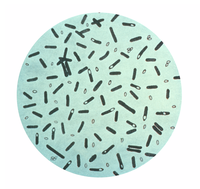
Photo from wikipedia
Intradermal injection of botulinum neurotoxin is a frequently performed procedure in aesthetic dermatology to improve facial skin tone, texture, fine wrinkles, and enlarged pores. In practice, botulinum neurotoxin type A… Click to show full abstract
Intradermal injection of botulinum neurotoxin is a frequently performed procedure in aesthetic dermatology to improve facial skin tone, texture, fine wrinkles, and enlarged pores. In practice, botulinum neurotoxin type A is also used to reduce skin oiliness of the face. There is increasing evidence that acetylcholine plays specific roles in sebum production, suggesting that botulinum neurotoxin type A may reduce sebum production by interfering with cholinergic transmission between sebaceous glands and autonomic nerve terminals. Botulinum neurotoxins can also inhibit several pathogenetic components of acne development, suggesting that botulinum neurotoxins can be used as a safe and effective treatment modality for acne and other skin disorders related to overactivity of sebaceous glands. This review aims to explore the current evidence behind the treatment of facial seborrhea and acne with botulinum neurotoxin type A.
Journal Title: Toxins
Year Published: 2021
Link to full text (if available)
Share on Social Media: Sign Up to like & get
recommendations!